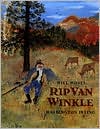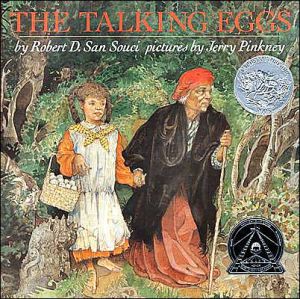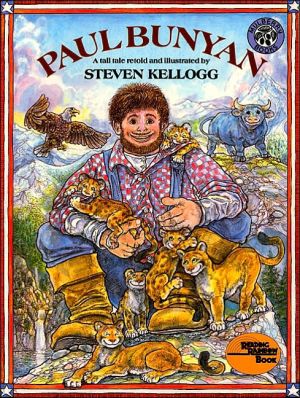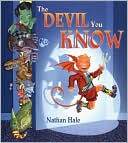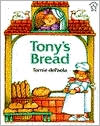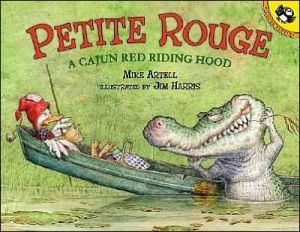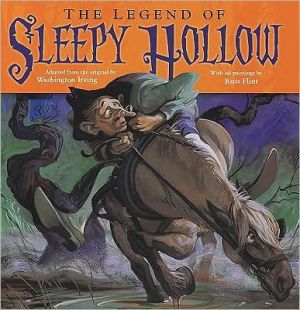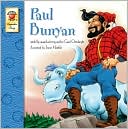Rip Van Winkle
Washington Irving's masterpiece has entranced readers for over 165 years, and though many artists have illustrated this classic, none has so perfectly captured the mysterious adventures of Rip and the boisterous crew of Dutchmen as the great American artist N. C. Wyeth. In ten richly colored paintings and twenty-six vivid line drawings, Wyeth brilliantly recreated the world of eighteent-century life in the Catskill Mountains.\ Join henpecked farmer Rip Van Winkle as he escapes to the hills...
Search in google:
Rip Van Winkle travels into the Catskill Mountains to spend the day, but somehow falls asleep and wakes up to a changed world. He had slept for 20 years! Where is his family? Find out what happened to Rip Van Winkle in this cautionary tale! Beautifully illustrated, this classic tale will capture children’s interest and spark their imagination page after page, encouraging a love of reading that is vital to success in school and life! Children will find hours of entertainment in the pages of these timeless tales! Our Brighter Child® Keepsake Stories are delightfully illustrated classic stories of magic, imagination, and inspiration that will delight children again and again! Collect all of the titles in this wonderful series today! Select titles available in an English/Spanish bilingual version! Publishers WeeklyReaders who haven't sat down recently with Irving's classic tale, or those who have yet to be introduced to it, are in for a treat. Written in 1820, the story of the slumbering Dutchman is remarkably fresh, told with verve and panache. In keeping with the caliber of the prose, Kelley's artwork echoes the classic tradition (and in fact occasionally brings to mind N. C. Wyeth). His light-dappled landscapes and portraits are drawn on a grand scale, and rendered in sombre, autumnal hues that hint at the story's innate mystery. Irving's puckish wit and droll descriptions are a delight. For more mature readers, the effort of navigating Irving's occasionally florid style is rewarded with many such morsels. Beautifully designed and elegantly type-set on high-quality stock, this book is as much a pleasure to hold as it is to read. Ages 12-up. (Oct.)
Chapter One\ \ \ Rip Van Winkle\ \ \ A Posthumous Writing Of Diedrich Knickerbocker\ \ \ [The following tale was found among the papers of the late Diedrich Knickerbocker, an old gentleman of New York, who was very curious in the Dutch history of the province and the manners of the descendants from its primitive settlers. His historical researches, however, did not lie so much among books as among men; for the former are lamentably scanty on his favorite topics, whereas he found the old burghers, and still more their wives, rich in that legendary lore so invaluable to true history. Whenever, therefore, he happened upon a genuine Dutch family, snugly shut up in its lowroofed farmhouse under a spreading sycamore, he looked upon it as a little clasped volume of blackletter, and studied it with the zeal of a book-worm.\ The result of all these researches was a history of the province during the reign of the Dutch governors, which he published some years since. There havebeen various opinions as to the literary character of his work, and, to tell the truth, it is not a whit better than it should be. Its chief merit is its scrupulous accuracy, which indeed was a little questioned on its first appearance, but has since been completely established; and it is now admitted into all historical collections as a book of unquestionable authority.\ The old gentleman died shortly after the publication of his work, and now that he is dead and gone, it cannot do much harm to his memory to say that his time might have been much better employed in weightier labors. He, however, was apt to ride his hobby his own way; and though it did now and then kick up thedust a little in the eyes of his neighbors, and grieve the spirit of some friends for whom he felt the truest deference and affection; yet his errors and follies are remembered "more in sorrow than in anger," and it begins to be suspected that he never intended to injure or offend. But, however his memory may be appreciated by critics, it is still held dear by many folk whose good opinion is well worth having; particularly by certain biscuit-bakers, who have gone so far as to imprint his likeness on their new-year cakes, and have thus given him a chance for immortality almost equal to the being stamped on a Waterloo medal or a Queen Anne's farthing.]\ By Woden, God of Saxons,\ From whence comes Wensday, that is Wodensday,\ Truth is a thing that ever I will keep\ Unto thylke day in which I creep into\ My sepulchre.\ Cartwright.\ \ \ Whoever has made a voyage up the Hudson must remember the Kaatskill Mountains. They are a dismembered branch of the great Appalachian family, and are seen away to the west of the river, swelling up to a noble height and lordingit over the surrounding country. Every change of season, every change of weather, indeed, every hour of the day, produces some change in the magical hues and shapes of these mountains, and they are regarded by all the good wives, far and near, as perfect barometers. When the weather is fair and settled, they are clothed in blue and purple, and print their bold outlines on the clear evening sky; but sometimes, when the rest of the landscape is cloudless, they will gather a hood of gray vapors about their summits, which in the last rays of the setting sun will glow and light up like a crown of glory.\ At the foot of these fairy mountains the voyager may have descried the light smoke curling up from a village, whose shingle roofs gleam among the trees just where the blue tints of the upland melt away into the fresh green of the nearer landscape. It is a little village of great antiquity, having been founded by some of the Dutch colonists in the early times of the province, just about the beginning of the government of the good Peter Stuyvesant (may he rest in peace!), and there were some of the houses of the original settlers standing within a few years, built of small yellow bricks brought from Holland, having latticed windows and gable fronts surmounted with weathercocks.\ In that same village, and in one of these very houses (which, to tell the precise truth, was sadly time-worn and weatherbeaten), there lived many years since, while the country was yet a province of Great Britain, a simple good-natured fellow of the name of Rip Van Winkle. He was a descendant of the Van Winkles who figured so gallantly in the chivalrous days of Peter Stuyvesant and accompanied him to the siege of Fort Christina. He inherited, however, but little of the martial character of his ancestors. I have observed that he was a simple good-natured man; he was, moreover, a kind neighbor and an obedient henpecked husband. Indeed, to the latter circumstance might be owing that meekness of spirit which gained him such universal popularity; for those men are most apt to be obsequious and conciliating abroad who are under the discipline of shrews at home. Their tempers, doubtless, are rendered pliant and malleable in the fiery furnace of domestic tribulation, and a curtain lecture is worth all the sermons in the world for teaching the virtues of patience and long-suffering. A termagant wife may therefore, in some respects, be considered a tolerable blessing; and if so, Rip Van Winkle was thrice blessed.\ Certain it is that he was a great favorite among all the good wives of the village, who, as usual with the amiable sex, took his part in all family squabbles, and never failed, whenever they talked those matters over in their evening gossipings, to lay all the blame on Dame Van Winkle. The children of the village, too, would shout with joy whenever he approachaaed. He assisted at their sports, made their playthings, taught them to fly kites and shoot marbles, and told them long stories of ghosts, witches, and Indians.\ Rip Van Winkle. Copyright © by Washington Irving. Reprinted by permission of HarperCollins Publishers, Inc. All rights reserved. Available now wherever books are sold.
\ Publishers Weekly\ - Publisher's Weekly\ All the elements of Washington Irving's 1820 tale come into play in this retelling, but it's Moses's (The Legend of Sleepy Hollow) Hudson River backdrop that lends elegance to the volume. From the opening scene of great schooners winding their way downriver through the Catskill Mountains, the illustrations situate readers in an enchanted land. Moses lays the groundwork for lazy, good-natured Rip's transformation by portraying the protagonist propped up against a tree, whether in his own yard or just outside the town tavern where he gathers with his friends. Scorned by his wife one too many times, Rip heads for a hilltop with a vista of birches, pines and peak autumn colors. Moses successfully evokes the feeling of time stopped with his portrait of the mysterious band of revelers who lead Rip astray: the Dutchmen garbed in nearly clownish costume, a lone wisp of smoke escaping above the russet mountaintops, the ground in pale, neutral colors. The paintings aptly capture the momentous changes that occur during Rip's 20-year sleep (1769-1789): trees are larger, the tavern sign that once depicted King George III now displays General Washington, and new homes dot an otherwise familiar landscape. Small vignettes serve as close-ups to reveal the personalities of the various characters, though an illustration depicting Rip "surrounded by a troop of children, hanging on his coattails, clambering up his back" would have played up Rip's more positive attributes. Moses's tangible representation of Irving's setting and characters serves as a faithful introduction to the tale. Ages 4-up. (Sept.) Copyright 1999 Cahners Business Information.\ \ \ \ \ Publishers Weekly\ - Publisher's Weekly\ Readers who haven't sat down recently with Irving's classic tale, or those who have yet to be introduced to it, are in for a treat. Written in 1820, the story of the slumbering Dutchman is remarkably fresh, told with verve and panache. In keeping with the caliber of the prose, Kelley's artwork echoes the classic tradition (and in fact occasionally brings to mind N. C. Wyeth). His light-dappled landscapes and portraits are drawn on a grand scale, and rendered in sombre, autumnal hues that hint at the story's innate mystery. Irving's puckish wit and droll descriptions are a delight. For more mature readers, the effort of navigating Irving's occasionally florid style is rewarded with many such morsels. Beautifully designed and elegantly type-set on high-quality stock, this book is as much a pleasure to hold as it is to read. Ages 12-up. (Oct.)\ \ \ Children's Literature\ - Susie Wilde\ Kelley uses his pastels to create amazing oil-like representations. His style, colors and light reflect the tones of the Flemish masters and revive the Hudson Valley life of the early Dutch settlers. Green predominates, giving a woodsy feel while creating a strong sense of setting and time. There is a softness of illustration that fits the long-ago fantasy story and that presents a dreamy representation of the main character who sleeps away so many years.\ \ \ \ \ Children's Literature\ - Deborah Zink Roffino\ Loads of lore-little people and the specter of Henry Hudson-float through this unabridged tale, buoyed by the museum quality watercolors. This classic tale of a ne'er-do-well who sleeps through the Revolutionary War teaches the clothing, language and mind-set of those hearty early Dutch settlers in the mountains above the Hudson River. Rackham's full page plates glow with autumn colors and exquisite detail.\ \ \ \ \ Children's LiteratureOne does not know which to admire most, the story line that Washington Irving weaves or the artistry of the illustrator, Arthur Rackman. Readers of all ages have been enchanted with the story of Rip, who sleeps for twenty years, since it was first published in 1819. There have been many who have illustrated the story but none have captured the essence of the character and the beauty and magic of the Catskills as well as Arthur Rackman. You can see why Rackman has been recognized as the foremost illustrator of the 20th century when you view his paintings throughout the book. This deluxe edition of the American classic, with thirty-four of Rackman's paintings, makes a splendid gift to any child. 2000 (orig. 1819), Sea Star Books,\ \ \ \ \ School Library JournalGr 1-3In this version of the classic tale, Rip Van Winkle escapes to the hills to avoid work, meets little men with long beards, parties until he falls asleep, and awakens 20 years later. All of this is told in a controlled vocabulary suitable for beginning readers. However, this retelling is so watered-down that most of the story's flavor and nuances are lost. Rip goes to the woods to hunt, but in Bergen's tale he goes fishing. In the original, Rip and the little men get drunk on liquor; here, he drinks cider. Cook's watercolor and gouache illustrations are lovely, but his talent is wasted here. Introducing children to the classics is a good idea, but not at the expense of the literature. Rip Van Winkle Little, Brown, 1988, retold and illustrated by John Howe, or Washington Irving's Rip Van Winkle Puffin, 1994, retold and illustrated by Thomas Locker, are suitable for this audience while retaining the integrity of the original story.Elaine Lesh Morgan, Multnomah County Library, Portland, OR\ \
